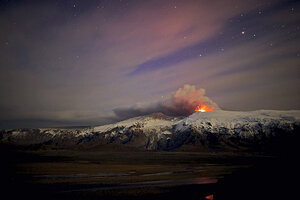How an Iceland volcano works: what Eyjafjallajökull might do next
Scientists trying to forecast the behavior of the Iceland volcano, Eyjafjallajökull, use words like 'Surtseyan.' What does that mean?

Eyjafjallajökull is still causing problems for air travel in northern Europe, but scientists suggest that the Iceland volcano might be transitioning to a new eruption pattern.
Newscom
The big news from Iceland Tuesday: Eyjafjallajökull may be shifting from a Surtseyan eruption to a more Strombolian mode.
This is a good thing.
As if the volcano itself wasn't enough of a phonetic nightmare, the attempt to understand what Eyjafjallajökull is actually doing – and when it will stop – has thrown the world into the thrall of volcanologists and their own language.
Strombolian or Surtseyan, Plinian or Hawaiian?
They're all ways of describing how volcanoes erupt – and how Eyjafjallajökull is erupting is of vital consequence to the more than three-quarters of a million would-be air travelers wondering how long an unpronounceable Icelandic volcano is going to hold them hostage.
What's the latest news?
Reports about what Eyjafjallajökull is doing now are mixed.
Overnight Monday, the volcano coughed up a new ash cloud that some worried might threaten to shut down many of the European airports that were just reopening.
But fresh news reports Tuesday added credence to observations volcanologists and amateur enthusiasts have been making online for several days: that the Eyafjallajökull eruption appears to be transitioning from a predominantly ash-producing event to a lava-producing one.
For Europe's airport-bound, a forecast of a less-ashy Eyjafjallajökull is just what they have been waiting for.
In volcanologist parlance, it's a shift from a Surtseyan eruption to a Strombolian.
Ash vs. lava
Surtseyan eruptions are all about water. The name is taken from an undersea Icelandic volcanic eruption in 1962 that created a new island, Surtsey, in the Atlantic.
With Eyjafjallajökull, the tremendous quantities of ash generated are primarily due to the reaction of the volcano with the glacier atop it, parts of which have melted and turned to glacial water during the eruption.
When eruptions encounter water, the water is heated, "flashes to steam and expands explosively, thus fragmenting the magma into exceptionally fine-grained ash," according to San Diego State's "How Volcanoes Work" website.
Eyjafjallajökull's exceptionally fine-grained ash is what is keeping European planes out of the sky.
But evidence is now suggesting that Eyjafjallajökull has consumed much of the glacier over its crater, meaning there is less and less water to react with the magma and form ash. The result could be an eruption typified more by the lobbing of lava bombs from the crater and onto the volcano's own slopes.
This is called a Strombolian eruption – a name that comes from the Italian island-volcano of Stromboli, which erupts almost constantly in this way.
Scientists caution against making any conclusions with certainty. The volcano could open up a new crater under a different part of the glacier, giving it fresh water supplies to turn into ash. Or the composition of the magma spewing from the crater could change, affecting how much ash is produced.
But for a world weary of volcano-watching, "Surtseyan" could well become a dirty word.
